 Most viewed - Koka 甲賀市 Most viewed - Koka 甲賀市 |

Koka Ninja House (Koka-ryu Ninjutsu Yashiki) is the former residence of Mochizuki Izumonokami, the leading Koga ninja family of the 53 Koka ninja families. 望月出雲守 MAP1230 viewsThe house is in its original location in the Koka area of Shiga Prefecture.
|
|

The Ninja House, built in 1703, is owned and maintained by a local medicine company having ninja roots. Many Koka ninja were makers of medicine as a front for their clandestine activities. This background also made them expert at making gunpowder.1220 viewsNot a National Historic Site, but it should be.
|
|

As a theme park, the Koka-no-Sato Ninjutsu-mura or Koka Ninja Village offers a good tourist sampling of ninja in a hidden village of former ninja houses transplanted to this "village." Entrance to Koka Ninja Village, tucked away in a hidden, lus1212 viewsEntrance to Koka Ninja Village, tucked away in a hidden, lush forest. Quite far from the nearest train station (Koka Station on the Kusatsu Line). You can call them from the train station to be picked up.
|
|

The Mizugumo Water Spider Pond where you can walk on water. A few visitors, wearing ninja costumes, try it out.1152 views
|
|

Metal finger claws worn on the fingertips.1099 views
|
|

There he goes, not exactly walking on water. Just dragging himself across with the rope. This is only for anime-like amusement. This is not how the ninja did it.959 views
|
|
|

Ladder going to the 2nd floor. There's also a trap door on the floor below the ladder where the ninja could hide. Notice the rope. The ninja hiding under the floor would tug the rope connected to the 2nd floor.883 views
|
|

The Ninja house (Ninja yashiki) is one of the main attractions of the Ninja Village. This was an actual ninja house belonging to the Fujibayashi ninja family. It was disassembled and transplanted here from Ohara Ichiba in Koka.863 views
|
|

The first room you see in the house is the living room. You can sit and have free "ninja tea" while waiting for a guided tour of the house. Along with the geisha, the ninja is one of the most recognized but misunderstood things about Japan.834 views
|
|

Shuriken target practice at the Shuriken Dojo in Koka Ninja Village, Shiga Prefecture. 手裏剣道場826 views
|
|

Ninja armored suit for protection against swords.823 views
|
|

Trap door on the floor opened.810 views
|
|

Water spider (mizugumo): How the ninja did it. This drawing from the Koka Ninja House shows how it was done. The ninja sat on the board inside the wooden ring and waded through the water while partially submerged. His wooden clogs had small flippers.781 views
|
|

Whoa, almost fell into the water!756 views
|
|

Real ninja shuriken throwing star knives on display. Made of steel, they come in many different shapes.737 views
|
|

Grab the rope and step into the foot rings. Of course, ninja never wore a bright red costume. You can rent a ninja suit in various colors for 600 yen.729 views
|
|

Koka Ninja Museum also has showcases with various ninja costumes, documents, weapons, etc. The museum is kind of rundown though.707 views
|
|

Closet with a trap door on the floor.701 views
|
|

Tsuchiyama-juku in Tsuchiyama-cho was the 49th of the 53 stations of the Tokaido Road, accessible by this "Aikuru" bus from Kibukawa Station (JR Kusatsu Line and Ohmi Railways). It takes 20-30 min, but the bus does not run so often.690 viewsTsuchiyama-juku in Tsuchiyama-cho was the forty-ninth of the fifty-three stations of the Tokaido Road, following Sakanoshita-juku in Mie. It is right after Suzuka Pass on the Suzuka mountains, one of the two most difficult sections of the Tokaido. Travelers thus were happy to see Tsuchiyama. Nicknamed "Ai no Tsuchiyama," the town is working hard to preserve its old buildings. The Tsuchiyama-juku Honjin where Shogun Tokugawa Iemitsu and Emperor Meiji lodged is still intact and well maintained. The Tsuchiyama Tokaido Museum is also a major attraction. Special thanks to Uno Yoshinobu who was my guide in Tsuchiyama.
|
|

Shuriken throwing knives.688 views
|
|

Other activities.684 views
|
|

Ninja's secret language. A codified system.676 views
|
|

Ceiling of Ninja House. Directly below the thatched roof.670 views
|
|

Little ninja at target practice.669 views
|
|

Ninja sword, very short.667 views
|
|

Soft rubber shuriken (toys). Special thanks to Takayuki Mochizuki (ninja descendant) for taking me to this Koka Ninja House.660 views
|
|

Shinobi Shrine is what you first see. Worships all the nameless ninja who died. The ninja never tried to gain fame. They remained unknown. 志能備神社659 views
|
|

Inside the ninja house. A hearth with a escape hatch at the bottom.654 views
|
|

Inside the trap door is a hole and tunnel leading to a well in the garden outside. Hence the water.646 views
|
|

Tools for making medicine (including gunpowder). Many Koka (Koga) ninja were medicine makers. It was a disguise and a means to gather information from people when they went around selling medicines. Koka ninja were always in contact with the local people.643 views
|
|

Honolulu Advertiser newspaper from Hawaii featuring a photo of a ninja from Koka who performed at Ala Moana Shopping Center in 1990.643 views
|
|

Ninja house attic showing the thatched roof.642 views
|
|

Ninja looked at a cat's eyes to find out what time it was. If the iris was almost closed, it was noon. If dilated, it was late at night. Must've been troublesome to find and snatch a cat to find out what time it was.635 views
|
|

A flaming star635 views
|
|

Revolving door (opened). The floor also has a trap door (see next photo) where you can go down and escape through a tunnel leading to a well in the garden outside.631 views
|
|

A pair of floating rings with a platform in the middle.629 views
|
|

Ninja well with an escape tunnel which you can almost walk through.629 views
|
|

Map of Japan showing numerous ninja schools which existed during the feudal era. Iga-Ueno and Koga ninja were the most famous.629 views
|
|

Maki-bishi spikes thrown on the ground to poke your feet. These are made from dried water chestnuts (aquatic plant found in marshes). One of the four spikes will point upward.628 views
|
|

Trying my shuriken skills. You throw it with an overhand throw (like a baseball) and not like a frisbee. Also see my YouTube video here.625 views
|
|

Hearth with a escape hatch at the bottom. A tour guide shows you the gimmicks of the house.622 views
|
|

The 2nd floor, between the first floor and ceiling, has a very low height which can entrap an intruder going upstairs.612 views
|
|

Shuriken throwing knives.610 views
|
|

Display case showing ninja costumes. Real ninja mainly wore one of seven disguises instead of the stereotypical black costume. They could be dressed as a priest, merchant, jester, etc.610 views
|
|

Inside Koka Ninja Museum which opened in 1983. The dirt-floored room has various ninja ladders.601 views
|
|

Ninja tools601 views
|
|

This room has display cases showing various ninja weapons, tools, and costumes. The ceiling is also quite low, designed to impede the wielding of samurai swords.597 views
|
|

Shinobi Shrine has a statue of Daikokuten, one of the seven gods of good fortune. He is worshipped for good marriage, food, and prosperity. Made during the early Edo Period, it's Japan's largest wooden statue of Daikokuten. 大黒天594 views
|
|

The rope is connected to a noise maker on the 2nd floor here. The intruder would then think that the ninja is on the 2nd floor and go up the ladder in pursuit. When the intruder is on the 2nd floor, the ninja below the trap door would remove the ladder.594 views
|
|

The left sliding wooden door is very heavy, about 50 kg, making it difficult to open. This buys more time for the ninja to escape.593 views
|
|

Giant Buddha's hand. Used in a 1982 ninja movie. The hand has the same scale as the Giant Buddha's hand in Nara's Todaiji temple.592 views
|
|
|
|

Shigaraki tanuki racoon dogs.586 views
|
|

Entrance to another room on the first floor. Although the Koga ninja and Iga ninja (in Mie Prefecture) were the most famous, there were actually numerous ninja groups in many other parts of Japan as well. They were most active during wars.584 views
|
|

Dart-shaped shuriken. Shuriken were not only star-shaped. These were either thrown straight-on, or thrown while the point rotated 180 degrees turning toward the target. It was difficult to throw, and much practice was required..582 views
|
|

Path to Koka Ninjutsu-mura Village. Admission is 1,000 yen for adults. Cheaper for students. Open 10 am - 5 pm. Free shuttle bus available from JR Koka Station. Phone: 0748-88-5000577 views
|
|

Small gun concealed as a sword.576 views
|
|

Ninja dolls572 views
|
|

Hooks for hoisting ropes on walls, etc. The Koka ninja reluctantly moved to Edo (Tokyo) around 1634 as requested by the shogun, and worked as castle guards, gathered intelligence on daimyo lords, and formed a gun battalion.570 views
|
|

The wooden railing on the right is slimmer than the left one. It means it is removable, allowing the ninja to escape from the 2nd floor.566 views
|
|

Ninja souvenirs562 views
|
|

One of Japan's renown and historical centers for pottery, Shigaraki's heart is the Shigaraki Ceramic Cultural Park.560 views
|
|

That rope goes to the second floor (see next photo).558 views
|
|

Ladder going up to the attic.554 views
|
|

The Ninja House also displays autographs by celebrities who visited the house. This is actor Harrison Ford who visited in Feb. 2000. He came unannounced with a taxi driver, interpreter, and his son.554 views
|
|

Going through the trap door.550 views
|
|

Trap door behind a scroll with the kanji "shinobi" (stealth).549 views
|
|

Maki-bishi made of steel. Used for escape when they encountered an enemy. Many of the ninja's weapons were designed to buy time for the ninja to escape.548 views
|
|

The upper walls have explanations about the Koka ninja and Mochizuki ninja family. "Koka" is the correct pronunciation, but the kanji can also be pronounced "Koga" which has become more common.540 views
|
|

Gunpowder case537 views
|
|

Roof with ninja family crest.533 views
|
|

Stairs to go back down to the 1st floor. There's a rotating door. Ninja worked behind the scenes and were very secretive. They hardly told others about their activites nor left written records. Sometimes they worked as spies or mole.526 views
|
|

Shuriken Dojo Hall 手裏剣道場525 views
|
|

Next to the Ninja house is the Koka Ninja Museum (Koka Ninjutsu Hakubutsukan). This was also a fomer house transplanted here. 甲賀忍術博物館520 views
|
|

The Ninja house was built in 1842. There is a guide (dressed in ninja costume) inside to show you around.515 views
|
|

Medicine ad sign reading Ninjutsu-gan. For belly aches. Although the ninja's medicine-making remains today, the art of ninjutsu is ironically no longer practiced in Koka. It is not a martial art like karate and judo.514 views
|
|

Real ninja obviously did not wear a pink costume, but in the manga/anime world, pink looks cute.504 views
|
|

The array of ninja weapons and tools was very impressive. This Ninja House strives to dispel some of the myths and misconceptions of the ninja. A visit is highly recommended.504 views
|
|

Ceiling of Ninja House.502 views
|
|

Monument for Sarutobi Sasuke, a famous Koga ninja who was born in Koka. However, he was only fictional character. Ninjas never tried to become famous. 猿飛佐助の碑501 views
|
|

Ninja costumes for sale. 10,000 yen for adult costume, and 7,000 yen for children's size.501 views
|
|

This entire ceiling was designed to fall down on any assailant in this room.501 views
|
|

The veranda is another escape route after opening trick windows from the inside. Ninja avoided direct combat and preferred to defend themselves and escape from enemies. Assassination was only a minor part of their activities.500 views
|
|

Swinging down a rope.500 views
|
|

Blow tube and blow darts.499 views
|
|

The famed Bansenshukai Ninja Bible detailing ninja tools and techniques. This is a replica.496 views
|
|

Medicine packages from Koka ninja-related medicine companies. Even today, Koka has numerous medicine manufacturers.491 views
|
|

Castle wall to climb on.489 views
|
|

They wore wooden geta clogs with flippers which helped them propel themselves underwater. The wooden floating ring is collapsible and quite light. Almost like balsa.489 views
|
|

The Koka Ninja House also has a Shuriken Dojo. Pay 200 yen for five shuriken throwing stars (300 yen for 10) and try hitting the bull's eye.488 views
|
|

Contrary to popular belief, ninja cannot walk on water. "Mizugumo" means water spider. To move across water, they used a wooden floating ring shown here, and sat in the middle.488 views
|
|

Small revolving door connected to a closet. The Koka ninja's main activity was gathering information. As they traveled and sold medicines, they always talked to people and their customers. They tried to find out how many guns the enemy had, etc.483 views
|
|

Bullets with various gauges.482 views
|
|

Path down to Koka Ninja Village. Lots of greenery. MAP481 views
|
|

Wall to climb on474 views
|
|

The Koka Ninja House is located 2 km from JR Konan Station on the JR Kusatsu Line. There are no buses going to the Ninja House. The house is open every day 9 am - 5 pm. Closed Dec. 27-Jan. 1. Admission is 600 yen for adults. 望月出雲守471 views
|
|

The Saio princess wears a juni-hitoe (12-layer) robe reserved only for Imperial family members. For this festival in 2009, the Saio princess is portrayed by 20-year-old Chiaki Koyama (神山千明) from Shigaraki, Koka. 470 views
|
|

Shuriken Dojo has a few stalls. For a few hundred yen, you can throw real shuriken at wooden targets.468 views
|
|

A sketch shows how they were "water spiders." They were largely submerged in the water, with the wooden ring also submerged, but buoyant enough for them to float across while kicking through the water with the flipper clogs.464 views
|
|

Swinging chain with weights on the ends. Wrap it around the opponent's neck.462 views
|
|

One room's upper walls display a chronological history of the Koga ninja.461 views
|
|

Shigaraki pottery lessons459 views
|
|

Straw sandals with metal claws for traction.459 views
|
|

Straw ninja hat with a deep brim to hide their face. Dressing like a priest, merchant, etc., would arouse the least suspicion while they traveled.456 views
|
|

Gift shop selling medicines, tea, and ninja goods.452 views
|
|

Manga cells. Ninja manga characters are famous. However, real ninja never became famous. Being famous in name or face would greatly decrease the value of that ninja.451 views
|
|

Three out of five of my shuriken at least stuck on the board. But all missed the target which is quite low. Probably geared for kids.449 views
|
|

447 views
|
|

Saio princess in juni-hitoe kimono.445 views
|
|

For 500 yen, you can rent a ninja costume of various colors.443 views
|
|

Giant tanuki at Shigaraki Station. Wish they removed that pay phone.441 views
|
|

Outdoor stage, where they hold events like the Miss Kunoichi Contest.439 views
|
|

Ninja phone straps439 views
|
|

Blow darts with poison tips maybe.434 views
|
|

Medicines made by the company which owns the house.425 views
|
|

Healthy "Ninja tea." Free samples in the living room.425 views
|
|

Medicine (gunpowder?) case.416 views
|
|

Outside the ninja house. This ninja house is very impressive. It does have an air of authenticity, although there are, unavoidably, a few touristy elements. This house should be designated as a Important Cultural Property or an National Historic Site.405 views
|
|

The festival started at 11:30 am with the Saio princess carried on a palanquin arriving at a small park called Yume no Ogawa next to Ono Elementary School. 391 views
|
|

This is an autograph by Shiga Governor Kada Yukiko who visited the Ninja House on April 24, 2009. In red reads "Mottainai," her motto meaning "Wasteful," in reference to spending of tax dollars.386 views
|
|

Wooden ad sign for aspirin.381 views
|
|

Held on the last Sunday in March, the Tsuchiyama Saio Princess Procession reenacts the Tsuchiyama segment of the Saio Gunko procession when a new Saio princess traveled from Kyoto to Ise to be the High Priestess of Ise Grand Shrines in Mie Prefecture. 363 viewsThe Saio princess was an unmarried, young Imperial princess, often the Emperor's daughter or sister, who was appointed (by divination) to be the High Priestess of Ise Grand Shrines from the 7th to 14th centuries. For about 660 years, over 60 Saio princesses served at Ise Grand Shrines.
The journey took 5 nights and 6 days, and passed through Otsu and Tsuchiyama in Shiga Prefecture. Tarumi Tongu in Tsuchiyama was one of the five palaces where the Saio lodged along the way.
Take the "Aikuru" bus from Kibukawa Station (JR Kusatsu Line and Ohmi Railways). After about 30 min., get off at Ono Higashi-guchi (大野東口) and walk to Ono Primary School.
|
|

Art work on a vending machine.352 views
|
|

352 views
|
|

Similar to the beckoning cat, the Shigaraki tanuki is a common good luck charm placed at the entrance of homes and shops. Tanuki of all sizes for sale year round.348 views
|
|

Saio princess going to Tarumi Tongu in Tsuchiyama, Shiga.335 views
|
|

Saio princess of the Ai-no-Tsuchiyama Saio Gunko Matsuri festival in March.314 views
|
|

Minakuchi-juku was the fiftieth of the fifty-three stations of the Tokaido Road. The most prominent remnant is Minakuchi Castle. Short walk from Minakuchi Jonan Station and Minakuchi Ishibashi Station on the Omi Railway Line.303 viewsOmi Railway Line at Minakuchi Ishibashi Station platform, the closest station to Minakuchi-juku.
|
|

The Saio drinks the tea.282 views
|
|

The memorial is a short walk from Shigarakigushi Station.280 views
|
|

Memorial for Safety272 views
|
|

Tsuchiyama Saio Princess Procession あいの土山斎王群行261 views
|
|

Along the way, you will see pottery shops with tanuki dolls to catch your attention.260 views
|
|

At Yume no Ogawa park, the Saio princess performed the Misogi-shiki purification ceremony in Tsuchiyama, Shiga. 禊ぎ式257 views
|
|

250 views
|
|

Shigaraki Station 信楽駅243 views
|
|

Pine tree from Tsuchiyama at the site of Shinagawa-juku's Honjin in Tokyo.241 views
|
|

On the Shigaraki Kogen Railway Line, get off at Shigaraki Station at the end of the line. 信楽駅241 views
|
|

Banners for the Saio Gunko festival. It was a great festival. A lot of people were behind the scenes to hold this festival, and thanks to them too. Also see my photos of the Saiku Matsuri here.232 viewsA similar festival is held in Meiwa, Mie Prefecture, the location of the Saiku Palace where the Saio princess resided near Ise.
|
|

Diamond Shiga's hot spring. Special thanks for Uno Yoshinobu for driving me around for my first trip to Tsuchiyama.229 views
|
|

Shigaraki Kogen Railways Shigaraki Station. You can take a bus to reach Shigaraki Ceramic Cultural Park in 5 min., or walk for 20 min. 信楽駅229 views
|
|

This is Shinagawa-juku in Tokyo, the site of the Honjin. On the left is a pine tree from Tsuchiyama.227 views
|
|

The Saio is actually on a wheeled cart.226 views
|
|

"Anagama" kiln diagram and explanation in Japanese and English.220 views
|
|

Minakuchi Jinja Shrine, which holds the annual Minakuchi Hikiyama Matsuri on April 19-20, is decorated for the festival. Map: https://goo.gl/maps/yZ2c6hMoGQJ2216 views
|
|
|

210 views
|
|

"Anagama" kiln.207 views
|
|

Noborigama sloping kiln 登り窯207 views
|
|

The tanuki have different faces and doing different things, even karaoke. Didn't see any looking like a photographer though.204 views
|
|

Miho Museum has several exhibition rooms featuring art from various parts of the world. It also has a restaurant and coffee shop.204 views
|
|

After reaching Higashi-Mitsuke Gate, backtrack back to the train station and cross the train tracks to the other side of the Tokaido Road. You will be heading toward Minakuchi Castle. Minakuchi manhole. Shiga Pref.202 views
|
|

If you go to Shigaraki by car, you will see large pottery shops along the road catching your eye with giant tanuki and small tanuki armies.201 views
|
|

"Noborigama" sloping kiln 登り窯198 views
|
|

Tea fields next to Tarumi Tongu. When the Saio princess was called back to Kyoto, she took a different route back to Kyoto.196 views
|
|

Shigaraki tanuki is said to bear Eight Lucky Omens (八相縁起).193 viewsShigaraki tanuki is said to bear Eight Lucky Omens (八相縁起). 1. The hat is protection from unexpected disasters. 2. The smiling face is for affability, 3. The large eyes is for seeing the situation and making correct and considerate decisions, 4. The large belly is for being calm as well as bold, 5. A sake flask in the left hand for innate virtue, 6. An unpaid bill in the left hand symbolizes trust, 7. Large gonads between the legs which is the money bag for prosperity, and 8. A thick tail for reliability and stability no matter what.
|
|

If you like the tanuki raccoon dog, this is the place to be.188 views
|
|

187 views
|
|

Resembling a pair of praying hands, the train accident memorial is right next to the railway track.185 views
|
|

They dance to live music with drums, bell, and flute. The Kenketo Odori dance of Tagi Shrine is a National Intangible Folk Cultural Property. 国選択無形民俗文化財185 views
|
|

Placard holders called Waranbe (童部).183 views
|
|

Shigaraki Ceramic Cultural Park is in a large park-like area with various pottery facilities such as this Exhibition Hall of Industrial Ceramics. 産業展示館181 views
|
|

Bowls180 views
|
|

A dance by the Warawame child attendants. 180 views
|
|

Hiroshige's woodblock print of Minakuchi (51st post town on the Tokaido) from his "Fifty-Three Stations of the Tokaido Road" series. A summer scene of a few women drying gourd shavings to make kanpyo.180 views
|
|

179 views
|
|

Shigaraki Toki (Pottery) Matsuri banner178 views
|
|

Shigaraki Tanuki mascot walked around the site.178 views
|
|

Numerous Shigaraki pottery vendors display and sell their wares. MAP177 views
|
|

Tanuki faces. This one is probably the most typical in the modern age.176 views
|
|

Minakuchi Castle was originally built in 1634 as a rest place for shogun Tokugawa Iemitsu during his travels to and from Kyoto. But the shogun stayed at the castle only once.176 views
|
|

The Ceramic Art Market in Shigaraki Ceramic Cultural Park has ceramics artists having their own booth to sell their wares.174 views
|
|

JR Koka Station north (Kitaguchi) side. 174 views
|
|

A great time to visit Shigaraki is during the Shigaraki Pottery Festival (信楽陶器まつり) and Ceramic Art Market in mid-Oct. Bridge to the Shigaraki Pottery Fair in mid-Oct.173 views
|
|

172 views
|
|

Prices are quite reasonable. They sell pottery for any type of budget.171 views
|
|

Side entrances of noborigama kiln. 登り窯171 views
|
|

For about 660 years from the 7th century, over 60 Saio princesses served at Ise Grand Shrines. Each time there was a new emperor, a new Saio princess would be appointed to serve at Ise.170 views
|
|

Pottery vendor168 views
|
|

Vases168 views
|
|

Inside the kiln. This one was open and empty, but some were closed and you could feel the warmth on the door.168 views
|
|

Kenketo Odori dance at Tagi Shrine, Tsuchiyama, Shiga.168 views
|
|
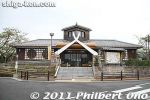
Held only once every five years, the Aburahi Festival with the yakko-furi procession was held by Aburahi Shrine in Koka, Shiga Prefecture, Japan on May 1, 2011.168 viewsThe procession features yakko samurai laborers who carry a trunk and sing. Others also dance. The procession makes a circular route near Aburahi and Koka Stations on the JR Kusatsu Line. Aburahi Station on the JR Kusatsu Line. Very nice design.
|
|

Inside a large pottery shop.167 views
|
|

Inside Tanuki-kan store.166 views
|
|

JR trains no longer run to Shigaraki directly.165 views
|
|

164 views
|
|

Bargains to be found.164 views
|
|

"Noborigama" kiln164 views
|
|

164 views
|
|

A short bus ride takes you to Shigaraki Ceramic Cultural Park, opened in June 1990. Open from 9 am to 5 pm, closed on Mon. (open if a national holiday and closed on Tue.). This is Shigaraki's main attraction and home of Shigaraki-yaki pottery.164 views
|
|

My video of the Aburahi Matsuri. The yakko-furi procession reenacts the samurai coming to worship at the shrine. You have to watch this video to understand the soundless photos.164 views
|
|

"Noborigama" kiln explanation in Japanese and English. 登り窯163 views
|
|

When I visited in mid-Oct., the Shigaraki Ceramic Cultural Park was holding the Ceramic Art Market. Notice the tents for the ceramic artists selling their works.163 views
|
|

The new Saio princess traveled from Kyoto to the Saiku palace near Ise Grand Shrines. It took 5 nights and 6 days. From 886 to 1264 (378 years), one stop along the way was Tarumi Tongu in Tsuchiyama.163 views
|
|

The bridge obviously has ceramic materials.162 views
|
|

Vending machine trash bin with tanuki design at Shigarakigushi Station.162 views
|
|

Sotoen's noborigama kiln is 15 meters wide, 30 meters long, and 3.5 meters high. It has eleven chambers going up a slope. 登り窯162 views
|
|

Shigaraki-no-miya Palace ruins. National Historic Site MAP161 views
|
|

Tagi Daimyojin-no-Miya Shrine is dedicated to the water god, for protection against floods. Long ago, nearby rivers often flooded this area. 龍樹大明神宮161 views
|
|

Welcome to Shigaraki. On special days such as pottery fairs, just follow the crowd from the train station.160 views
|
|

Route taken by the Saio princess from Kyoto to Saiku Palace, near Ise Grand Shrines. The journey took 5 nights and 6 days, and passed through Shiga at Seta (Otsu), Kafuka (Koka), and Tarumi before going to Mie at Suzuka and Ichishi. 159 viewsThe Saio princess stayed at a different palace each night, and three of them were in Shiga. The temporary palace for the Saio princess was called Tongu (頓宮). Only the Tarumi Tongu's former location is known today.
|
|

Ceramic seats158 views
|
|

The Saio princess was an unmarried, young Imperial princess, often the Emperor's daughter, who was appointed (by divination) to be the High Priestess of Ise Grand Shrines in Mie Prefecture from the 7th to 14th centuries.156 viewsThis Ai-no-Tsuchiyama Saio Princess Procession was started in 1998.
|
|

155 views
|
|

155 views
|
|

154 views
|
|

Pottery kilns require large amounts of wood.154 views
|
|

Held on May 3 by Tagi Jinja Shrine (龍樹神社) in Tsuchiyama, the Kenketo Matsuri Festival is highlighted by the Kenketo Odori Dance. The road to the shrine is marked with festival banners.154 views
|
|

This is one of two pottery fair sites during the Shigaraki Pottery Festival.153 views
|
|

She and her entourage arrived to perform the Misogi-shiki purification ceremony. 禊ぎ式 MAP153 views
|
|

This festival reenacts the Tsuchiyama leg of the Saio Princess Procession. It started at Ono Elementary School and proceeded to the site of Tarumi Tongu, one of the five temporary palaces for the Saio.153 views
|
|

Shigaraki Ceramic Cultural Park also has pottery kilns. Here's one "Anagama" cave kiln. 152 views
|
|

Shigaraki Ceramic Cultural Park is called Togei no Mori in Japanese. It is operated by Shiga Prefecture. Free admission. 陶芸の森 MAP152 views
|
|

Giant tanuki dressed as a Yokozuna grand champion sumo wrestler.152 views
|
|

Diamond Shiga, a luxury hotel with a golf course.151 views
|
|

151 views
|
|

Shigarakigushi Station on the Shigaraki Kogen Railway Line. This is where you get off to see the Shigaraki-no-miya Palace Ruins or the train accident memorial. 紫香楽宮跡駅151 views
|
|

At the parking lot is this Tanuki-kan store full of tanuki.150 views
|
|

More outdoor ceramic art. This is outside the Institute of Ceramic Studies where invited artists in residence create and do research and workshops and lectures are held.150 views
|
|

First they go along the main street toward Shigaraki Station. In the background is a Shigaraki pottery shop.150 views
|
|

Also in Shigaraki is Miho Museum, designed by I.M. Pei, in the middle of the mountains. From Shigaraki Station, it's a 25-min. bus ride. (Or 50 min. by Teisan Bus from JR Ishiyama Station in Otsu.) This nice tunnel leads to the museum.149 views
|
|

Stone plaque with the names of the 42 fatalities, including five employees of Shiga Kogen (Highland) Railways (SKR).148 views
|
|

Kenketo dancer, Shiga148 views
|
|

Kyoto-based Emperor Shomu first built a Detached Palace in Shigaraki in 742. This became the the Shigaraki-no-miya Palace.147 views
|
|

Kamoshika-so Onsen lodge, offering hot spring waters next to a scenic river. Phone: (0748) 69-0344144 views
|
|

Owls too144 views
|
|

Inside a side entrance of a noborigama kiln. 登り窯144 views
|
|

At the top of the hill is the Museum of Contemporary Ceramic Art called Togeikan. 陶芸館144 views
|
|

Entrance to Tarumi Tongu. The five Tongu palaces were built anew for each Saio procession and then dismantled after the procession was completed. Therefore, there is no remains of the palaces, making it difficult to pinpoint the exact location.144 views
|
|
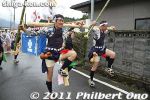
They repeat the same thing over and over. The hasami-bako yakko-furi unit dressed in red do not perform enroute. Apparently, they perform only at the major rest stops like at the shrine and Otabisho.144 views
|
|

143 views
|
|

Diamond Shiga's golf course.142 views
|
|
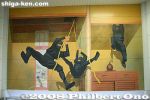
Ninja painting in Koka Station.142 views
|
|

Sports tanuki141 views
|
|

Lemme outta here...141 views
|
|

Confection141 views
|
|

Saio princess in Tsuchiyama, Koka.141 views
|
|
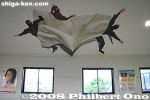
Ceiling painting of ninja appearing from a cloak. You can have someone "touch" the tip of the cloak.141 views
|
|
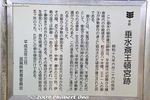
About Tarumi Tongu. (垂水頓宮) Tongu means temporary palace. There were five of them for the Saio princess between Kyoto and the Saiku palace in Ise.140 views
|
|

National Historic Site of Tarumi Tongu. From 886 to 1264 (378 years), a total of 31 Saio princesses lodged at Tarumi Tongu. 垂水頓宮 140 viewsIn 1935, the Japanese government sent a team of scholars to Tarumi and they found solid evidence of the Tarumi Tongu beg located here. Remains of the palace's earthen walls and wells were found in this area. In 1944, this area designated as a National Historic Site.
|
|

Notice the little shrine in the background to mark the Tarumi Tongu site. 皆さん、大変お疲れさまでした。とても優雅なお祭りでした。皆に伝えます。140 views
|
|

139 views
|
|

Koka City Hall, Shigaraki Branch139 views
|
|

This is a unique court lady called the Uneme (釆女) chosen from an aristocratic family and who was in charge of food and drink. She wears a special wardrobe. She is played by Emi Oe (大江絵巳) from Kyoto.139 views
|
|

Kibukawa Station, terminus of the Omi Railway Line and connection to the JR Kusatsu Line.139 views
|
|
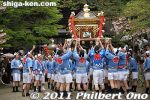
139 views
|
|

138 views
|
|

My YouTube video of the Kenketo Odori Festival.138 views
|
|

137 views
|
|

A warehouse converted into a pottery fair.137 views
|
|
| 1139 files on 5 page(s) |
1 |
 |
 |
|